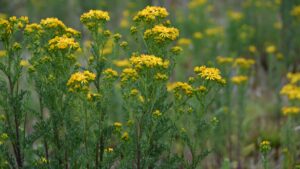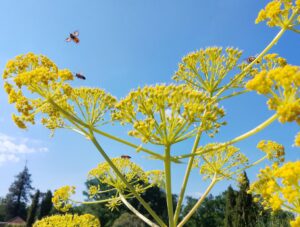
Podcast Episode 36 – The Dove From Above
PODCAST EPISODE 36: The Dove From Above Join us on a beautiful June evening for episode 36 of the Knepp Wildland Podcast. We’re joined by
Home / Knepp’s grazing animals, absent predators and meat that doesn’t cost the Earth

Matt Phelps | Lead Ecologist
One of the questions I’m often asked relates to the annual culling of our free-roaming grazing animals. It goes like this: “If you have to reduce the number of animals at Knepp every year to sustain a healthy ecosystem, why not do away with them altogether, so you don’t have to kill them?” And, sometimes, more simply: ‘We know cows are bad for the planet, why do you have them at all?’
People are now rightly alarmed about the environmental impacts of industrial meat and dairy production. We cannot ignore the fact that industrial livestock agriculture is one of the most devastating drivers of the joint climate and biodiversity crises. It contributes significantly to habitat loss, insect declines, water pollution, greenhouse gas emissions, animal suffering and health problems in humans. But our animals are very different. They have a positive effect on the environment. We couldn’t do rewilding without them.
At Knepp, as our free-roaming animals go about their lives, their myriad disturbances stimulate other life – just as vast herds of aurochs, tarpan, wild boar, elk and deer would have influenced biodiversity in our landscape thousands of years ago. Their dung restores the soil, and feeds dung beetles all year round – keystone species that can then recolonise farmland. They transport seeds around the landscape in their gut, hooves and fur. Their wallowing around ponds and streams creates niches for mud plants to colonise and amphibians and water insects to feed and breed. They break branches and rub against tree-trunks and paw up the grass to scent-mark. Stallions and bulls create territorial dust baths like golf bunkers. The compaction of the ground under a favoured scratching branch creates ‘ephemeral ponds’ – habitat for specialist water beetles and fairy shrimp. Everything these animals do causes mini disturbances which create space for new life to take root. By restoring the soil, stimulating plants to regrow shoots and invest in deeper roots, and creating new wetlands they also increase the storage of carbon, helping in the fight against climate change. When Knepp was farming, the land emitted huge amounts of carbon. Now it is a significant carbon sink.
As the animals ‘browse’ Knepp’s scrubland, nibbling, ripping and munching on hawthorn, blackthorn, sallow, dogrose and bramble, they stimulate the bushes to develop tighter re-growth, with a greater profusion of flowers and thorns. When a gardener prunes a rose bush, this is exactly what happens – the bush responds as if it’s being predated by a browsing animal. The shrub can even ‘read’ the enzymes in a herbivore’s saliva, which helps stimulate even greater defences. All of these defensive reactions create denser, thornier vegetation, heavier with nectar, pollen and seeds which benefits birds, insects and small mammals. It also provides the perfect thorny protection for nesting nightingales and other songbirds which migrate to us each year from sub-Saharan Africa.
Turtle doves benefit too. This is one of our most threatened species with fewer than 200 pairs in Sussex, one of its last strongholds, down more than 97% since the 1960s. At Knepp, we had 21 pairs in 2024 – more than 10% of the population in the county. And they are receiving a boost from an unlikely ally: our pigs. Our small herd of Tamworths rootle their way through the scrubby wildlands, turning over the turf as they go in search of earthworms, beetle larvae, acorns and other subterranean treats. This creates patches of bare ground, into which germinate a smorgasbord of wildflowers including vetches, clovers, fluellens and scarlet pimpernel (now rare in much of the countryside) whose tiny protein-rich seeds are vital food for turtle doves.
Invertebrates such as mining bees also benefit from the increased availability of nest sites, which in turn attract their own predators, such as the downland villa bee-fly. Previously unseen at Knepp, the bee-fly is now thriving thanks to the abundance of mining bee colonies in a landscape with compacted pathways created by large mammals.
But the secret to the positive influence of our animals is numbers. Too few, and our land would swiftly become closed canopy woodland – species-poor habitat. Almost all creatures and plants need either full sunlight or dappled light to thrive. Too many large herbivores, on the other hand, would eat out all the vegetation, turning the land into ubiquitous, simplified grassland (much like overgrazed farmland) – which is again, poor habitat for wildlife. What benefits biodiversity the most is a kaleidoscope of diverse, dynamic habitats, where the battle between vegetation growing up and animals grazing and browsing it is never won by one side or the other.
In ‘wilderness’ areas such as the Serengeti in Africa or Yellowstone National Park in the US, the number of herbivores is largely regulated by apex predators. But we don’t have wolves, bears, lynx, wild cat or wolverines in the UK. We hunted them to extinction many centuries ago.
We could – in theory – stock our land with herds of a single sex so they can’t breed. But it’s important to us that our herds live in natural, multi-generational groups and have offspring – one of their most natural functions. We consider it an animal right. But it’s also important for the effect dynamic herds have on the ecosystem. Without the stress and interest of complex social interactions, animals do little other than plod around and eat. In our ponies this can lead to laminitis, a painful and sometimes incurable disease of inflammation – caused by simply eating too much. The range of positive disturbances on the land also drops significantly, and single sex herds can be dangerous. Most attacks on people and dogs by cattle in farmed landscapes are by young heifers or steers penned together in a field like bored, unruly teenagers without parental control. Our cattle are led by dominant matriarchs who transmit the wisdom of experience to the younger generations – where and what to eat, where to lie up in storms etc – and who keep even boisterous young males in check.
So, to keep numbers low enough to have a positive impact on the environment, we humans must act as apex predator. Our red and fallow deer are shot on site by a licensed deer stalker who knows the land intimately and has unparalleled field craft. The pigs and cattle are sent to a small organic abattoir at the end of the growing season. We cull before the beginning of winter so there will be plenty of grass and vegetation for the remaining animals through the long, cold, non-growing months. Animals are assessed in terms of their age, health and individual traits. Our stock manager refers to culling as an accelerated form of human-managed evolution. In this context, we can control herd dynamics by favouring good traits (good physical condition and bone structure) over bad (a tendency to get mastitis or other ailments), ultimately leading to animals that are even better suited to their wild roaming life here. In many ways, we’re reversing the breeding selections that have been governed by domestication over centuries.
All the butchery and maturation of the meat is carried out at Knepp by our expert team in our state-of-the-art, sustainable butchery. They treat the meat with the utmost respect, ensuring that nothing is wasted. We favour ‘nose to tail’ eating, using traditional and more unusual cuts in our Wilding Kitchen and in recipes for our Knepp Wild Range online shop. Scraps that we can’t eat go to feed our penned white storks, part of our white stork reintroduction programme in the rewilding project, or are turned into rich compost which grows organic vegetables in our Market Garden.
At every stage in the decision-making, nature comes first. The number of animals we cull is driven by the needs of the wilding project and not by eyeing the bank balance. Their meat, though, is of the highest quality, because, unlike animals in industrial systems that have been stuffed with indigestible grain and high-performance protein feeds or routinely fed antibiotics, our animals have browsed and grazed at will on what they are designed to eat, naturally regulating their own diet and health. Meat produced in this way is proven to be good for human health and is therefore in demand from the health conscious, ethically-minded consumer as well as from chefs and foodies who appreciate its quality and taste.
We’re passionate about telling this story because we feel the issue of meat eating is so polarised in the media. It’s complex. But we know how vital our free-roaming animals are to kick-starting flourishing ecosystems again. It’s important that their role is recognised and that we face full-on our part in enabling them to work their magic.
To find out more, visit the Wild Range Meat website or book onto one of our limited Pasture to Plate safaris this summer.

PODCAST EPISODE 36: The Dove From Above Join us on a beautiful June evening for episode 36 of the Knepp Wildland Podcast. We’re joined by

Matt Phelps | Lead Ecologist It’s mid-June and the countryside is quietly gearing up for its summer crescendo. You might have noticed it already— what

Moy Fierheller | Deputy Head Gardener Visit Knepp’s rewilded Walled Garden The fine, fairy-tale spring continues and the Met Office reports it’s the sunniest in
Knepp Wildland Safaris, our gardens and campsite are all about the quiet and patient observation of nature.
Some of the species we are likely to encounter are shy or can be frightened by loud noises or sudden movements. Our campsite with open-air fire-pits, wood-burning stoves and an on-site pond is unsuitable for small children.
For this reason, our safaris, garden visits, holiday cottages and campsite are suitable only for children of 12 and over.